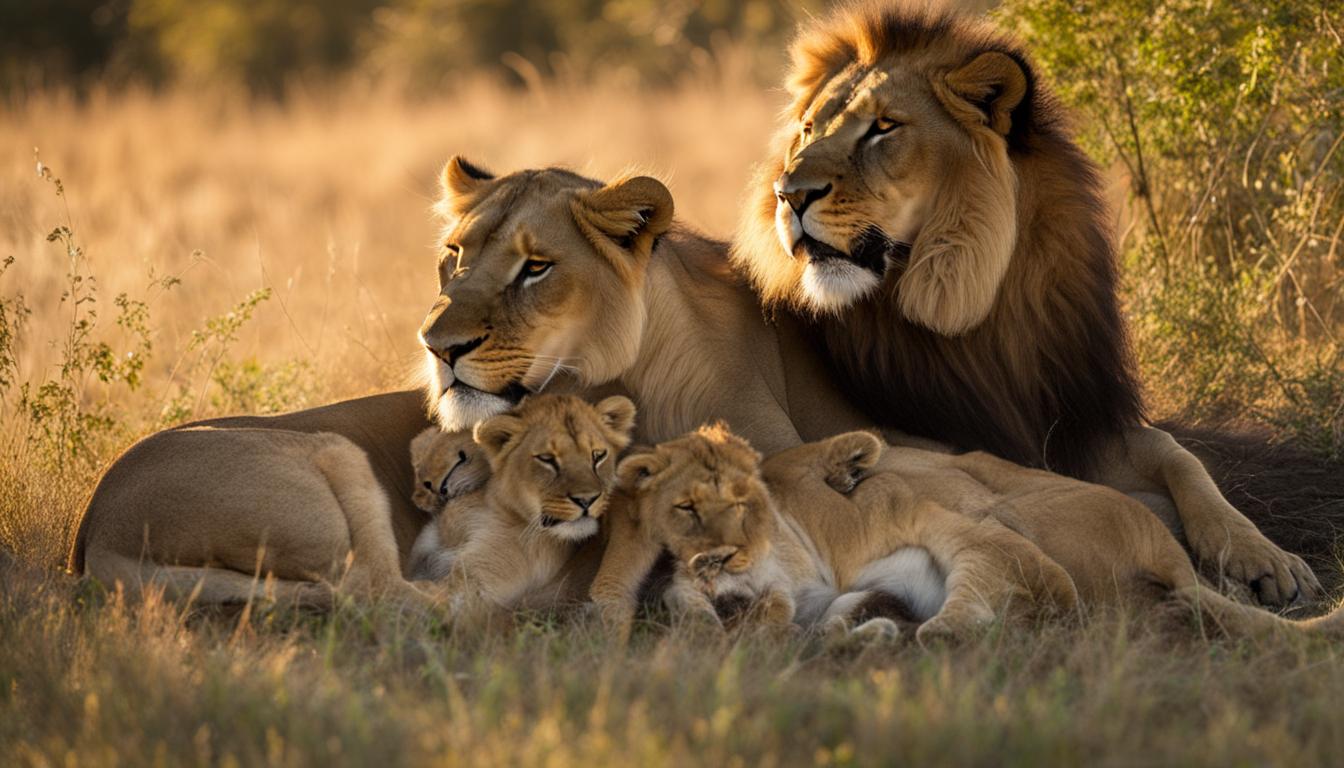Lions engage in grooming behaviors to maintain their physical health and hygiene, as well as to strengthen social bonds within their pride. They use techniques such as head rubbing and licking to reinforce social connections and create a group odor. Male lions typically rely on head rubbing, while females often use licking. Lions choose grooming partners based on kinship and age, and the behavior serves to establish and maintain hierarchies within prides.
Key Takeaways:
- Lions groom themselves and their pride members to maintain health and hygiene.
- Head rubbing and licking are common grooming techniques used by lions.
- Grooming helps establish and maintain hierarchies within prides.
- Grooming partners are chosen based on kinship and age.
- Grooming reinforces social connections and creates a group odor.
The Importance of Grooming in Lion Society
Grooming plays a crucial role in lion society. It serves multiple functions that are essential for the overall well-being and functioning of the pride. Firstly, grooming helps lions maintain their physical appearance and overall health. They use their tongues to clean their fur, removing dirt, parasites, and injuries. This grooming behavior ensures that lions are clean and free from harmful pathogens, promoting good hygiene within the pride.
Furthermore, grooming is a social bonding activity that strengthens relationships and reinforces social bonds among pride members. It serves as a way for lions to establish and maintain hierarchies within the pride. Dominant lions often groom subordinate lions as a way of asserting their status and maintaining control, while subordinates groom dominant lions as a sign of respect. Through grooming, lions create a sense of unity and cooperation within the pride, contributing to its overall cohesion and functioning.
“Grooming in lion society serves multiple functions, helping lions maintain physical health, hygiene, and social bonds.”
The importance of grooming in lion society is also evident in the establishment of group odor. Lions use techniques such as head rubbing and licking to create a distinct group scent. This group odor serves as a form of communication, allowing lions to identify members of their pride and reinforce social connections. Lions choose grooming partners based on kinship and age, further strengthening these social bonds within the pride.
| Grooming Functions | Description |
|---|---|
| Physical Health and Hygiene | Removing dirt, parasites, and injuries to maintain overall health |
| Social Bonding | Strengthening relationships and reinforcing social connections |
| Establishing Hierarchies | Asserting dominance and maintaining control within the pride |
| Group Odor | Creating a distinct scent for communication and social identification |
Overall, grooming is a vital behavior in lion society. It not only helps lions maintain their physical health and hygiene but also serves as a means of social bonding and communication within the pride. Understanding the importance of grooming provides valuable insights into the behavior and dynamics of lions in the wild.
Lion Grooming Behaviors
Lions, like many other social animals, engage in grooming behaviors as a means of maintaining their physical health and hygiene. Grooming is an essential part of their daily routine and serves various purposes within lion society. Let’s explore some of the common grooming behaviors observed in lions.
Grooming Techniques
Lions have developed unique grooming techniques to ensure proper care for themselves and their pride members. One of the most common grooming behaviors is self-grooming, where lions use their rough tongues to clean their fur, removing dirt and parasites. This meticulous self-grooming helps them maintain a clean and healthy coat.
Another significant grooming behavior observed in lions is mutual grooming. Lions engage in mutual grooming by licking and head rubbing each other. This behavior not only helps in maintaining hygiene but also strengthens social bonds within the pride. Mutual grooming is often seen among pride members, especially between individuals that have close kinship or social status.
Variations in Grooming Behavior
Grooming behaviors can vary among lion populations and subspecies, influenced by environmental factors and social dynamics. For instance, lions in arid environments may groom less frequently due to the scarcity of water and resources. Conversely, lions in humid environments may engage in more grooming activities to combat increased moisture and parasite presence.
Add a table for better understanding the variations in grooming behaviors among different lion subspecies, including differences in mane length, grooming frequency, and preferred grooming techniques.
| Lion Subspecies | Mane Length | Grooming Frequency | Preferred Grooming Techniques |
|---|---|---|---|
| African Lion | Full Mane | Regular | Licking and Head Rubbing |
| Asiatic Lion | Shorter Mane | Frequent | Head Rubbing |
| Barbary Lion | Thick and Dark Mane | Infrequent | Self-grooming |
Understanding the variations in grooming behaviors not only sheds light on lion ecology but also highlights the adaptability of these majestic creatures in different habitats.
The Role of Social Grooming in Lion Society
In lion society, social grooming serves multiple important functions. It not only helps lions maintain their physical health and hygiene but also plays a crucial role in reinforcing social bonds, establishing hierarchies, and maintaining group cohesion.
Grooming in lions is a mutual activity, where lions groom each other as a way to bond and establish social connections within the pride. Dominant lions often groom subordinates as a way to reinforce their status, while subordinates groom dominant lions as a sign of respect.
Through grooming, lions create a sense of community and cooperation within the pride. It is a behavior that strengthens social bonds, fosters trust, and enhances overall group unity. By spending time grooming each other, lions build and maintain relationships, ensuring the smooth functioning of the pride as a whole.
The Benefits of Social Grooming in Lion Society
There are several benefits to social grooming in lion society. Firstly, it helps to establish and maintain hierarchies within the pride. The act of grooming reinforces dominant-subordinate relationships and helps to establish social order.
Secondly, grooming serves as a form of communication among pride members. It helps to convey acceptance, trust, and respect within the group. Through grooming, lions build social connections and create a sense of unity and cooperation.
Lastly, social grooming also contributes to the overall well-being and health of individual lions. It helps to remove dirt, parasites, and injuries, promoting good physical hygiene and reducing the risk of infections.
| Benefits of Social Grooming in Lion Society |
|---|
| Establishes and maintains hierarchies |
| Serves as a form of communication |
| Promotes individual well-being and health |
Factors Influencing Grooming Behavior in Lions
Lion grooming behavior can be influenced by various factors, including environmental conditions and population density. Environmental factors, such as the climate and habitat in which lions live, can affect the frequency and intensity of grooming. For example, lions in arid environments may groom less frequently than those in humid environments due to the availability of water and the need to conserve energy. Similarly, the density of lion populations can also influence grooming behavior. In densely populated areas where resources are scarce and competition is high, lions may prioritize activities other than grooming.
Another factor that can influence grooming behavior is the availability of tools and resources for grooming. Lions may alter their grooming techniques based on the tools they have access to. For example, lions in captivity may have access to grooming tools provided by caretakers, while those in the wild rely solely on natural methods of grooming. The availability of suitable resting areas and resting time can also impact grooming behavior. Lions that have ample time and comfortable resting spots may engage in more grooming activities than those with limited resources.
Additionally, social dynamics within a pride can influence grooming behavior. Dominant lions may receive more grooming attention from subordinates as a way to reinforce social hierarchies and show respect. Subordinate lions may groom dominant individuals to strengthen social bonds and gain favor within the pride. The age and kinship of lions can also play a role in grooming behavior, with closer relatives engaging in more frequent and intensive grooming sessions.
| Factors Influencing Grooming Behavior in Lions | Description |
|---|---|
| Environmental Conditions | The climate and habitat in which lions live can affect grooming frequency and intensity. |
| Population Density | The density of lion populations can influence grooming behavior, particularly in areas with high competition for resources. |
| Availability of Tools and Resources | The access to grooming tools and suitable resting areas can impact grooming behavior. |
| Social Dynamics | Social hierarchies and relationships within a pride can influence grooming patterns. |
In conclusion, grooming behavior in lions is influenced by a combination of environmental, social, and resource-related factors. By understanding these factors, we can gain further insights into the complex social dynamics and adaptation strategies of these magnificent creatures.
Lion Grooming in the Wild
Lion grooming behaviors are not only observed in captivity but also in the wild, where they serve essential functions for both physical and social maintenance. In their natural habitat, lions engage in grooming to remove dirt, parasites, and injuries, ensuring their overall well-being. Additionally, grooming plays a crucial role in reinforcing social bonds and establishing hierarchies within the pride.
Lions in the wild groom themselves by using their tongues to clean their fur, a technique that helps to maintain their hygiene and physical appearance. Furthermore, mutual grooming activities among pride members are common, allowing lions to bond and establish social connections. Dominant lions often groom subordinates as a way to reinforce their position, while subordinates groom dominant lions to show respect and maintain harmony within the pride.
Grooming is instrumental in promoting cooperation, unity, and the overall function of lion prides. By engaging in grooming behaviors, lions create a sense of community and strengthen social cohesion. These practices are crucial for their survival and success in the wild, as they contribute to the overall well-being and functioning of the pride as a whole.
| Grooming in the Wild | Description |
|---|---|
| Grooming Techniques | Lions groom themselves using their tongues to clean their fur, removing dirt and parasites. |
| Mutual Grooming | Lions engage in mutual grooming activities to bond and establish social connections within the pride. |
| Social Cohesion | Grooming reinforces cooperation, unity, and overall well-being of the pride by maintaining harmony and social hierarchies. |
Conclusion
Lion grooming is an essential behavior that serves multiple purposes in their society. Not only does it help lions maintain their physical health and hygiene, but it also strengthens social bonds and establishes hierarchies within the pride.
Using their tongues to clean their fur, lions groom themselves to remove dirt, parasites, and injuries. They also engage in mutual grooming activities with other pride members, reinforcing social connections and creating a sense of unity.
It’s fascinating to note that grooming behaviors can vary among different lion populations and subspecies. Factors such as environmental conditions and population density can influence the frequency and intensity of grooming.
Understanding lion grooming provides valuable insight into their behavior and ecology in the wild. By studying these behaviors, we can gain a deeper understanding of how lions maintain their physical well-being and navigate their social structures.
FAQ
How do lions groom themselves and their pride members?
Lions groom themselves using their tongues to clean their fur. They also engage in mutual grooming activities with other pride members, such as licking and head rubbing.
What is the importance of grooming in lion society?
Grooming in lion society serves multiple purposes. It helps lions maintain their physical health and hygiene, strengthens social bonds, establishes hierarchies, and maintains group cohesion.
What are some lion grooming behaviors?
Lions engage in various grooming behaviors, including head rubbing, licking, and mutual grooming. Male lions typically rely on head rubbing, while females often use licking. Grooming behaviors may vary between lion populations and subspecies.
What is the role of social grooming in lion society?
Social grooming in lion society reinforces social bonds, establishes hierarchies, and maintains group cohesion. Dominant lions groom subordinates to reinforce their status, while subordinates groom dominant lions as a sign of respect.
What factors influence grooming behavior in lions?
Environmental conditions, population density, and competition for resources can influence grooming behavior in lions. Factors such as arid or humid environments and different lion populations and subspecies may lead to variations in grooming behavior.
How does lion grooming occur in the wild?
Lions groom themselves and their pride members in the wild as a means of physical and social maintenance. It helps remove dirt, parasites, and injuries, while reinforcing social bonds and establishing hierarchies within the pride.
What is the significance of lion grooming?
Lion grooming is a crucial behavior that contributes to the survival and function of lion prides. It fosters cooperation, unity, and overall well-being within the group.











